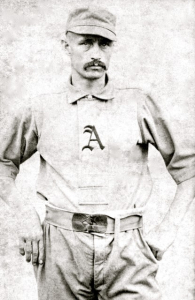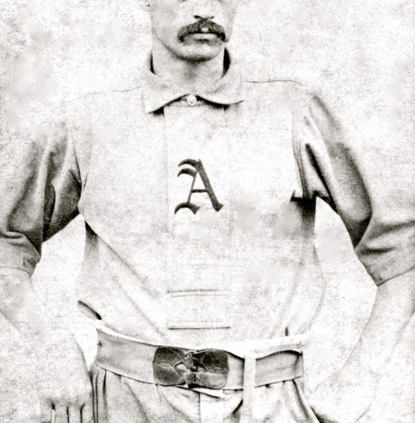August 1, 1883: Athletics continue dominance of Alleghenys
 The Philadelphia Athletics continued a season-long trend in their final meeting of the season with the Pittsburgh Alleghenys. The Athletics, who had won 11 of the first 13 games between the two in 1883 while outscoring the Alleghenys 104-55, maintained their dominance of the Alleghenys with a 19-2 victory. Athletics first baseman Harry Stovey provided an interesting footnote to the onslaught by becoming the first major-league player to hit 10 home runs in a season.
The Philadelphia Athletics continued a season-long trend in their final meeting of the season with the Pittsburgh Alleghenys. The Athletics, who had won 11 of the first 13 games between the two in 1883 while outscoring the Alleghenys 104-55, maintained their dominance of the Alleghenys with a 19-2 victory. Athletics first baseman Harry Stovey provided an interesting footnote to the onslaught by becoming the first major-league player to hit 10 home runs in a season.
An estimated crowd of 3,000 turned out for the Wednesday afternoon game played at Jefferson Street Grounds under clear skies with afternoon temperatures hovering in the mid-80s. A gentle 10 MPH breeze blew out of the southwest toward Jefferson Street, which ran behind right field.
The Athletics, who had won the first three games of the current series by outscoring the Alleghenys 44-18, started the day in first place in the American Association with a 40-18 record and a half-game lead over the St. Louis Browns (41-20). The Alleghenys were mired in sixth place with a 20-40 record, a distant 21 games behind the Athletics.
But the series finale began with question marks for both teams. Athletics pitcher Bobby Mathews, who had started and won the first two games of the series and had started 37 of the Athletics’ first 58 games, was injured in their 16-12 victory over the Alleghenys the day before.
“In the second inning, while Mathews (who had started the game in right field) was trying to steal second, he sprained his ankle badly and had to be carried off the field,” the Philadelphia Times reported.1 Athletics infielder Cub Stricker was apparently battling injuries as well and was “in a crippled condition covering second base,” according to the Pittsburgh Post-Gazette.2
The Pittsburgh pitching staff had to adjust when its ace left-hander Denny Driscoll, who had started 30 of the Alleghenys’ first 60 games, left the team the previous day after “being called home at noon on account of the dangerous illness of his wife.”3
Driscoll’s replacement was right-hander Jack Neagle, who was with his third major-league team of the season after being released by Philadelphia of the National League and Baltimore of the AA. Neagle’s last start with Baltimore was a 7-3 loss to the Athletics on July 20.
Neagle had started two of the first three games of this series – an 11-2 loss to the Athletics on July 28 and the 16-12 loss the day before this game. The start the day before was brief – he was pulled in the second inning after he “was hit hard in the first inning.”4
Stovey, who had doubled and hit a home run the previous day, got the carnage started in this game.
The Athletics won the toss and elected to bat first. After Jud Birchall walked to lead off the A’s first inning, Stovey “electrified the audience by hitting the ball over the left-field fence, about four feet inside the foul line.”5 According to the Philadelphia Inquirer, “Stovey made the longest hit ever seen on the ground, sending the ball twelve feet over the left field fence, completing the circuit of the bases long before the ball was returned.”6
Stovey, who had hit a total of 13 home runs in his first three major-league seasons with Worcester of the National League, made history with his majestic blast by becoming the first major leaguer to hit at least 10 home runs in a season. The previous record was held by Charley Jones, who hit nine home runs in 1879 while playing left field for the Boston Red Stockings of the National League. Stovey finished the 1883 season with 14 home runs, 66 RBIs, and a .304 batting average.
After Stovey’s home run, the Athletics added three more runs in the top of the first. Lon Knight doubled and scored on a single by Mike Moynahan. Jack O’Brien followed with another double to score Moynahan and eventually scored on an error by shortstop Frank McLaughlin. At the end of a half-inning, the Athletics led 5-0.
The Athletics added a run in the second when Birchall singled, took third when center fielder Bob Barr let the ball get past him, and scored on a passed ball by Billy Taylor.
Leading 6-0 in the third inning, the Athletics broke the game open with six runs, aided by three errors by the Alleghenys. With two down the Athletics began to parade around the bases. George Bradley reached on an error. Stricker followed with a double, Birchall singled, Stovey walked, Knight singled, Moynahan walked, and O’Brien reached on an error.
Down 12-0, the Alleghenys scored in their half of the third when, with two out, Ed Swartwood doubled, moved to third on a passed ball, and scored on Taylor’s single to center.
The Athletics added two more runs in the fourth. Bradley reached on an error by second baseman George Creamer, went to second on a bad throw by McLaughlin, and scored on a single by Stricker, who scored on another Alleghenys error to increase the Athletics’ lead to 14-1.
The two teams exchanged runs in the fifth. Moynahan singled and came around to score on a wild pitch and two passed balls. The Alleghenys scored their final run of the game when Barr, Neagle, Swartwood, and Taylor put together four successive hits.
In the top of the sixth, McLaughlin relieved Neagle, who allowed 10 hits and 15 runs while throwing four wild pitches. The right-handed-throwing McLaughlin mopped up the mess and limited the Athletics to single runs in the sixth and seventh innings and two in the ninth.
Knight, Moynahan, and O’Brien each had three hits and Stricker, healthy enough to play, had two hits for the Athletics, who had 16 hits and took advantage of five walks, six passed balls, and eight Alleghenys errors. Stovey, who drew a walk in the six-run third, also singled in Philadelphia’s two-run ninth. Only six of the Athletics’ runs were earned. Athletics starter Bradley earned the victory by going the distance and allowing just seven hits.7
The loss went to Neagle, who was 3-12 with a 5.84 ERA in 16 starts for the Alleghenys. His combined season record with the three teams was 5-23 with a 5.94 ERA in 30 appearances. His 1884 season (11-26 in 38 starts with the Alleghenys), was his last.
Taylor had three hits and Swartwood had two hits for the Alleghenys. Swartwood went on to lead the Association in batting average (.357).
With the win, the Athletics increased their lead to a full game over the idle St. Louis Browns. For the Alleghenys, the 19-2 drubbing was a fitting end to the season series, which saw them defeat the Athletics, 15-2, in the third game of the season, only to have the victory not count in the standings and classified as an exhibition.8
Sources
In addition to the sources cited in the Notes, the author consulted Baseball-Reference.com, Newspapers.com, and Retrosheet.org.
Notes
1 “Some More Big Batting,” Philadelphia Times, August 1, 1883: 4.
2 “19 to 2,” Pittsburgh Post-Gazette, August 2, 1883: 8.
3 “Some More Big Batting,” Philadelphia Times, August 1, 1883: 4.
4 “Some More Big Batting.”
5 “One Added to the Score,” Philadelphia Times, August 2, 1883: 4.
6 “Batting for Runs,” Philadelphia Inquirer, August 2, 1883: 2.
7 The box score in the Times gave Philadelphia 14 hits while the box score in the Inquirer gave 16. The newspaper accounts also differ on errors and earned runs — giving Allegheny 10 or 11 errors. One newspaper account has 8 earned runs, the other 6.
8 According to the Pittsburgh Post-Gazette, “Under the rules of the American Association all championship games must be umpired by an official umpire, and as Mr. (Charles) Daniels was alleged to be sick yesterday, an exhibition game was played. It was far from satisfactory and had a suspicious look all through. …” “If It Only Counted,” Pittsburgh Post-Gazette, May 4, 1883: 2.
Additional Stats
Philadelphia Athletics 19
Pittsburgh Alleghenys 2
Jefferson Street Grounds
Philadelphia, PA
Corrections? Additions?
If you can help us improve this game story, contact us.


